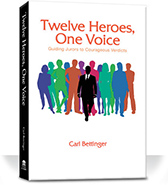Subscriber Benefit
As a subscriber you can listen to articles at work, in the car, or while you work out. Subscribe NowThe theme of the book, “Twelve Heroes, One Voice,” is why should jurors care? Why should they care enough to let go of the natural tendency to do nothing? This question is at the heart of every trial. The answer is they all secretly want to become a Jungian archetypal “hero.” The book is about how to make jurors the center of the story. Trial consultants and good trial attorneys have searched endlessly for new ways to engage jurors in the trial story.
As the title suggests, the single most important goal of voir dire is to empower the jurors, to show them that, if chosen, they are going to wield enormous power – by putting a value on someone’s life or deciding what it would take to stop nursing home misconduct.
The next most useful bit of advice by author Carl Bettinger is developing and telling your case using the story spine approach: “Once upon a time … And every day… Until one day… And as a result of that … Until, finally … And ever since then …” Our minds are pre-programmed to understand information that is presented in this format. By following this approach, you keep jurors’ attention and your focus on the case theme. Point of view is everything.
Bettinger reminds us that a courtroom is not a friendly place to most. What do jurors first see when they walk into the courtroom? Someone wearing a black robe, a bunch of people, obviously the lawyers, dressed in suits, staring at them as they come in, taking notes, whispering to one another as though inspecting prized cattle at an auction. It’s a very unfriendly, scary environment. The attorney should appreciate this and do whatever he can to ease the discomfort of jurors.
Bettinger makes a distinction between a “case” and a “story.” Your client has a story (not a case) and it is your role to communicate the story, using all the components mentioned above. All human beings yearn to take on the hero’s role and want to feel good (and confident) about their ultimate decision. Most good trial stories focus on a fight for survival and self-actualization. Good stories are about universal truths and must remind jurors of the greatest human accomplishments, not sadness, blame or shame.
He adds that at trial, your role as advocate is transformed into that of mentor, the defendant into a villain, the plaintiff into a brave victim, with the unwitting jury serving the role of hero. He quotes liberally from recent movies and the classics. He also uses transcript clips and illustrations.
Most lawyers fail to recognize that voir dire is not the time for advocacy. Voir dire is the time to show a genuine interest in other human beings simply because they are human beings who have been called upon to provide a great service. “And if you don’t show a genuine interest, if you try to fake it as though it’s a cheap date that you want for a one night stand, they’ll know that.”
Opening statement is time for you to define the story roles of everyone in the courtroom (presumably including the bailiff, court reporter, security, attorneys and judge). Cross- and direct examination furthers character development all the way to closing statement, which allows jurors to write the conclusion of the story allowing them to “save the day.”
This book contains 10 chapters and is 155 pages with appendix published by Trial Guides for $85. Chapter 1 introduces the “Hero-centric” storytelling model. Chapter 2 is about the importance of making the listener (jury) the center of the trial. Chapter 3 is making the trial story user-friendly and Chapter 4 is development and definition of the mentor, villain and victim character role. Chapter 5 is the application, with examples, of the story approach to both criminal and civil trials. Chapter 6 is devoted to dealing with case weaknesses in voir dire. Chapter 7 is opening statement and Chapter 8 is how to conduct direct and cross-examination using the “hero-centered” approach and sequencing witnesses. Chapter 9 is the closing statement: “Do you want just a song or do you want a hit?” Lastly, Chapter 10 is the closing thoughts and reasons to motivate jurors to adopt his approach to your cases.
The strength of the book is that it reminds me that we must continue to focus on giving jurors reasons to like our client and their story. It is a refreshing approach to jury selection where the juror, i.e., the listener, is the focus. It is about how to be a “total” lawyer, using psychology, literature and stories and is not about law books or legal theory. The book’s goal is to tell you how to make jurors want to listen and CARE through the art of effective storytelling. Although his approach is impressive, it is not a panacea in and of itself. It offers a much-needed adjunct to the existing body of work of David Wenner, Don Keenan, David Ball and Rick Friedman. Simply put, the book is all about transforming the jury into the hero.
This book is written for practicing attorneys. It does not offer fanciful legal advice or complex legal strategies and assumes you have those requisite skills by the time you become a trial lawyer. Bettinger, no stranger to big cases, is both a trial attorney and medical doctor; but, it is his understanding of the importance of storytelling that motivates the listener to want to vote for your client. His recent $54 million verdict in a nursing home case gives him credibility.•
Rodney Nordstrom, Ph.D., J.D., is a trial consultant with his company Litigation Simulation Services located in Peoria, Illinois. The opinions expressed in this column are those of the author.
Please enable JavaScript to view this content.
